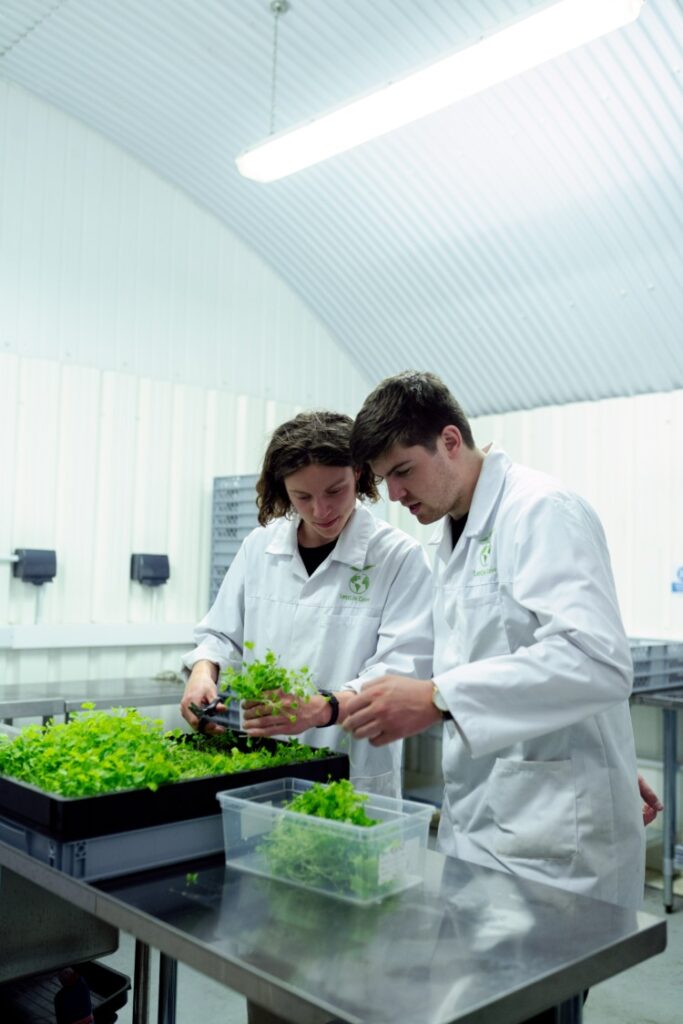Greek yogurt is a popular food that has been associated with a lot of health benefits, including being a good source of nutrients, and proteins and helping in weight loss. However, as it is becoming increasingly popular as a food product, the question is whether this yogurt variety is as healthy as its proponents claim.
Is Greek yogurt bad for the environment? What is its environmental impact?
What is Greek yogurt?

Greek yogurt is a traditional product from Greece and has a creamy texture that makes it popular as an ingredient or a stand-alone snack. The type of fermentation used for the yogurt differs from the usual processes, which means there are different health benefits associated with eating Greek yogurt than other varieties.
See Related: Best Conservation Posters
What are the ingredients of Greek yogurt?

The primary ingredient of Greek yogurt is milk. Other ingredients include water, salt, and a starter bacteria for fermentation called Lactobacillus bulgaricus.
Greek Yogurt Nutrition Facts per 100g Serving: Calories – 131 sweet whey protein – 13g Carbohydrate – 5g Sugar – 7.8g Fat – 9.5g Saturated fat – 6.5g Potassium – 169mg.
See Related: How To Be An Environmentalist
What is the process of Greek yogurt production?

In order to make Greek yogurt, the milk is first heated to a temperature of at least 180F. At this point, the lactic acid bacteria (Lactobacillus bulgaricus) that has been added will proliferate and produce enzymes that break down lactose into simpler sugars.
The milk is then cooled down and stirred continuously to prevent the formation of large curds. The pH at this point should be about 4.5, which can be lowered by adding more acid or raising the temperature.
With Rennet’s help, the milk clumps are broken, so no large yogurt lumps will be placed in small containers for fermentation. This is then left for 12 to 18 hours at a temperature of about 110F. At this time, the yogurt should be produced and enjoyed as consumers desire.
See Related: Best Conservation Books to Read
Greek yogurt health benefits

The way that Greek yogurt has been produced results in higher levels of protein and probiotics as well as lower levels of sugar and carbohydrate compared to other types of regular yogurts. Some studies also claim it is a good source of calcium and other nutrients.
See Related: Posters on Saving Earth
How does Greek yogurt affect the environment?

When considering the environmental impact of Greek yogurt, it is important to look at the process of Greek yogurt production and how much it can be consumed in terms of its health benefits.
The most common problem with producing this type of yogurt has been using excess amounts of water. This may also involve the presence of harmful chemicals like acid whey, which is a byproduct of the process of making cheese.
In 2010, acidic whey was identified as having significant environmental impacts, including contributing to global warming and negatively affecting the Earth’s ozone layer because of its presence in the atmosphere. Acid whey can be recycled, but it requires minimal processing.
See Related: Important Water Flows Pros and Cons
What is acid whey?

Acid whey is a yellowish liquid that is produced in the process of making cheese. This involves adding acid to milk to produce specific enzymes like rennet, resulting in whey decomposition. The resulting solid particles are called curds, and these can be used for a variety of food products, including Greek yogurt, ricotta cheese, and parmesan cheese.
The remaining liquid is used in baking or can be processed further to make a runny waste product like whey protein powder, livestock feed, and other similar products. Aside from acid whey in the environment, other environmental impacts can result from making Greek yogurt.
The most obvious one is how much water is needed to make it. It may also involve heavy metals used in industrial farming, antibiotics, and high levels of greenhouse gases that are given off because of industrial farm production methods.
See Related: Best Clothing Companies that Plant Trees
Separating acid whey components

Dean Sommer is one of the world’s leading experts on acid whey. He breaks down acid whey into its various components. You could spray lactic acids onto meat to remove germs if you extracted pure lactic acids. The next step was deciding who would be interested in buying and utilizing these parts.
Protein isolate, a by-product of the cheese industry, underwent a different image transformation and is now utilized in a variety of items, from sports drinks to milk to yogurt.
The CDR aims to eliminate this negative connotation, but there is a technological answer. After all, technology was developed to be implemented into food and sports drinks. The acid whey protein does not have a negative connotation as long as you can find a market.
If these non-food applications could be found for this product, its worth would increase, and the perceived image of this by-product would also change. If we can make money out of household waste disposal: then the collection of acid whey should be encouraged.
Looking at what has been mentioned above, it can be seen that there are many ways to produce Greek yogurt. However, each way impacts the environment due to factors like water footprint and other production methods used. More research needs to be done to determine how much of an effect these things have on the environment.
It is important to consider how much you are eating in terms of its health benefits, but it is also just as crucial to look at the production process itself when considering environmental impacts. The opinions expressed here are those of the author and do not necessarily reflect the position of FCRN or its sponsors.
See Related: Important Erosion Pros and Cons
Stockpiles of Whey Acid Building Up

Greek yogurt production produces about 70% of the whey acid in agriculture. Company officials have been evasive on the consequences of importing bulk quantities of whey from China, saying that they will announce them later.
As we’ve previously stated, any little leak in the environment might be catastrophic; there is currently no long-term solution. It’s an ecologically hazardous production process that isn’t sustainable. Check out the One Green Planet newsletter for more Animal, Earth, Life, and Vegan food and recipes.
See Related: Can You Put Banana Peels in Compost?
Whey Acid Dumping
For almost three years, the Minerva Cheese Factory, making strained yogurt and infant formula, poisoned the creek and eliminated Salmon River’s 1.5-mile-long natural fish environment. It is only the first of several recorded cases where acids were discovered.
The acid from whey depletes carbon dioxide from the water and kills fish and plants in its atmosphere when used in waterways. In 2008, a cheese factory in Saratoga Springs, NY, agreed to pay a $20,000 fine for dumping whey into a tributary of the Hudson River.
The impact of acid waste on global warming is significant. In Connecticut alone, about 200 million gallons of whey are deposited every year, according to the Organic Valley Farms company. The acidic liquid has been identified as contributing to releasing greenhouse gases like methane and carbon dioxide.
According to records, at least 5 million gallons of whey were documented in the Hudson River in 2008. The environmental damage was not stopped until it reached New York City, where residents complained about a foul smell and taste in their water supply. Most reports even suggested a potentially harmful unknown substance in the River.
Cowspiracy Report Reveals the Impact of Dairy Farming on the Environment

The first episode of Cowspiracy explored how much animal agriculture is related to climate change, deforestation, and species extinction. The documentary also focused on how the dairy industry has been found guilty of being one of the leading causes of these environmental problems.
One report claims that around 80% of greenhouse gas emissions are caused by animal agriculture on a global scale.
Cowspiracy emphasized how organic dairy farms can worsen climate change because of methane emitted from cows’ farts. Moreover, it disclosed how industrial animal agriculture is one of the leading causes of rainforest deforestation and habitat loss.
See Related: Best Books on Pollution
How does acid whey affect the atmosphere?

Acid whey can be a source of nitrous oxide emissions, a compound widely associated with the development of smog and acid rain. This gas generally contributes to global warming because it prevents heat from escaping the Earth’s atmosphere.
In terms of ozone layer protection, nitrous oxide can react with other compounds in the air to form nitric acid. This can then cause ozone loss by weakening stratospheric ozone, a barrier to harmful ultraviolet rays.
See Related: Ways to Help the Environment in Everyday Life
Fertilizer for livestock reaching the water

Another option for yogurt producers to solve the whey acid issue is to sell it to farmers to blend it and fertilize the land.
The difficulty is that the farm has a greater acidity, which converts waste products into useful things. Manure and fertilizer manufactured on-site in the soil sink into waterways, causing widespread worries. There are no reports on what specific pesticides or fertilizers are used when the milk is processed.
In 2014, only 200 gallons of whey from dairy farms in Indiana made it to a landfill, meaning there were about 1 million gallons in local waterways. The environmental damages associated with the release include wastewater treatment plants that released around 400,000 pounds of nitrogen and phosphorus into the Ohio River.
We should also start looking at other dairy products like cheese and butter since acid whey is not limited to yogurt alone. The problem can be resolved by using byproducts for energy creation, but some health-related issues are still yet to be solved.
See Related: Important Pros and Cons of Offshore Drilling
Conclusion
Greek yogurt in itself is not bad for the environment. The production process makes it worse since it uses whey acid for whey decomposition. This runny waste product contributes to global warming and causes harm to the natural environment. The yogurt food industry should implement environmentally friendly recipes.
FAQs
Does Greek yogurt produce waste?
Greek yogurt production does produce waste. Greek yogurt is made by straining regular yogurt to remove the liquid whey, resulting in a thicker, creamier yogurt. However, this straining process produces a significant amount of liquid waste, which contains lactose, lactic acid, and other organic compounds. Additionally, the leftover whey can be difficult to dispose of and can potentially harm the environment if not handled properly.
What is the main environmental problem caused by the production of Greek yogurt?
Greek yogurt production is a major contributor to the environmental problem of acid whey waste. Acid whey is a byproduct of Greek yogurt production that is difficult to dispose of and can be harmful to the environment if not handled properly. The high levels of lactose in acid whey can lead to oxygen depletion in waterways, which can harm aquatic life.
Is yogurt good for the environment?
Yogurt is generally considered to be good for the environment. This is because it is made from milk, which is a renewable resource that can be produced sustainably. Additionally, many yogurt manufacturers use environmentally friendly practices, such as sourcing milk from local farms and using renewable energy sources to power their facilities.
Is yogurt a hazardous waste?
Yogurt is not considered hazardous waste. It is a food product that is safe for consumption and disposal. However, it is important to properly dispose of expired or spoiled yogurt to prevent any potential health hazards.
Related Resources
